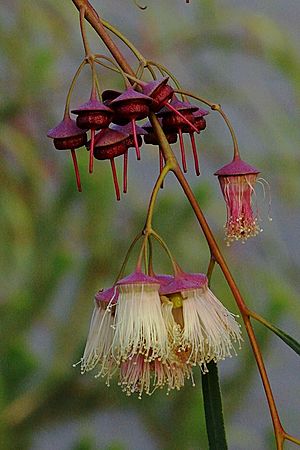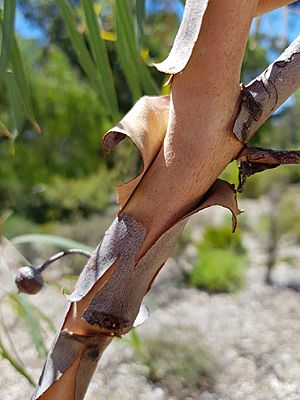Jingymia mallee facts for kids
Quick facts for kids Jingymia mallee |
|
|---|---|
 |
|
| Eucalyptus synandra capsules and blossom | |
| Conservation status | |
| Scientific classification | |
| Genus: |
Eucalyptus
|
| Species: |
synandra
|
The Jingymia mallee (scientific name: Eucalyptus synandra) is a special type of mallee plant. A mallee is a kind of eucalyptus tree that grows like a shrub. It has many stems coming from the ground. This plant is native to Western Australia. It has smooth bark and dull green leaves. Its flowers are creamy white to pink. They grow in groups of seven. After flowering, it produces fruit that looks like a small cup.
Contents
What Does Jingymia Mallee Look Like?
The Jingymia mallee is a mallee that usually grows between 3.5 and 10 meters (about 11 to 33 feet) tall. It can spread out from 3 to 7 meters (about 10 to 23 feet) wide. This plant has a special woody swelling underground called a lignotuber. This helps it regrow after fires.
Its bark is smooth and can be white or grey. Sometimes it looks powdery. The old bark peels off in long strips. This shows new bark underneath, which can be pink or brownish. The tree has an open top, called a canopy. This lets some sunlight shine through to the ground below.
Leaves, Flowers, and Fruit
Young plants have dull grayish-green leaves. These leaves are about 5.5 to 9 centimeters (2 to 3.5 inches) long. They are about 0.5 to 1.5 centimeters (0.2 to 0.6 inches) wide. Adult leaves are the same dull green color on both sides. They are long and narrow, like a spear. These leaves are about 10 to 17 centimeters (4 to 6.7 inches) long. They are about 0.5 to 1 centimeter (0.2 to 0.4 inches) wide. The base of the leaf narrows down to a short stem called a petiole.
The flower buds grow in groups of seven. They are on a thin stem called a peduncle, which is about 1 to 2.5 centimeters (0.4 to 1 inch) long. Each bud has its own small stem, called a pedicel, about 1 to 1.5 centimeters (0.4 to 0.6 inches) long. Mature buds are oval-shaped. They are about 1.1 to 2.1 centimeters (0.4 to 0.8 inches) long and 0.6 to 0.8 centimeters (0.2 to 0.3 inches) wide. They have a cup-shaped base and a pointy top that looks like a long, thin beak.
Jingymia mallee flowers from August to March. Its flowers are creamy white or pink. The lower parts of the flower's male parts (stamens) are joined together. After the flowers, the plant produces fruit. This fruit is shaped like a cone or a cup. It is about 0.4 to 0.6 centimeters (0.16 to 0.24 inches) long. It is about 0.9 to 1.3 centimeters (0.35 to 0.5 inches) wide. The fruit has five to seven valves that open to release seeds.
How Jingymia Mallee Got Its Name
The Jingymia mallee was first officially described in 1982. A botanist named Michael Douglas Crisp gave it its scientific name, Eucalyptus synandra. He wrote about it in a science journal called Nuytsia.
The name synandra comes from two ancient Greek words. "Syn" means "together," and "andra" means "male." This name refers to the plant's unique flowers. Their male parts (stamens) are joined together. The first plant used to describe the species was found near a place called Jingymia. This is why it is commonly known as Jingymia mallee.
Where Jingymia Mallee Grows
Jingymia mallee grows in several small groups of plants. These groups are found on sandy plains and small hills. This area is between Geraldton and Mount Marshall in Western Australia. It grows in sandy and gravelly soils that contain laterite.
There are about 27 separate groups of these plants. They contain about 1200 individual plants in total. These groups are spread out over an area about 300 kilometers (186 miles) long. Most of them are found north of Morawa to around Koorda. You can often find them along the sides of roads. They also grow on private land, in nature reserves, and on land used for grazing animals.
Jingymia mallee usually grows in areas with heath and scrub plants. It often grows alongside other eucalyptus species like Eucalyptus leptopoda and Eucalyptus ewartiana.
Protecting Jingymia Mallee
This mallee is considered "Threatened Flora." This means it is a rare plant that needs protection. The Department of Environment and Conservation (Western Australia) lists it as "Declared Rare Flora — Extant." This means it is a rare plant that still exists in the wild. Efforts are made to protect these plants and their habitats.
Growing Jingymia Mallee in Gardens
The Jingymia mallee is not a very common plant to grow in gardens. However, you can buy its seeds or young plants from special nurseries. This plant is good for gardens because it can handle dry weather. It grows best in full sunlight. When it flowers, it attracts birds like honeyeaters to the garden.



